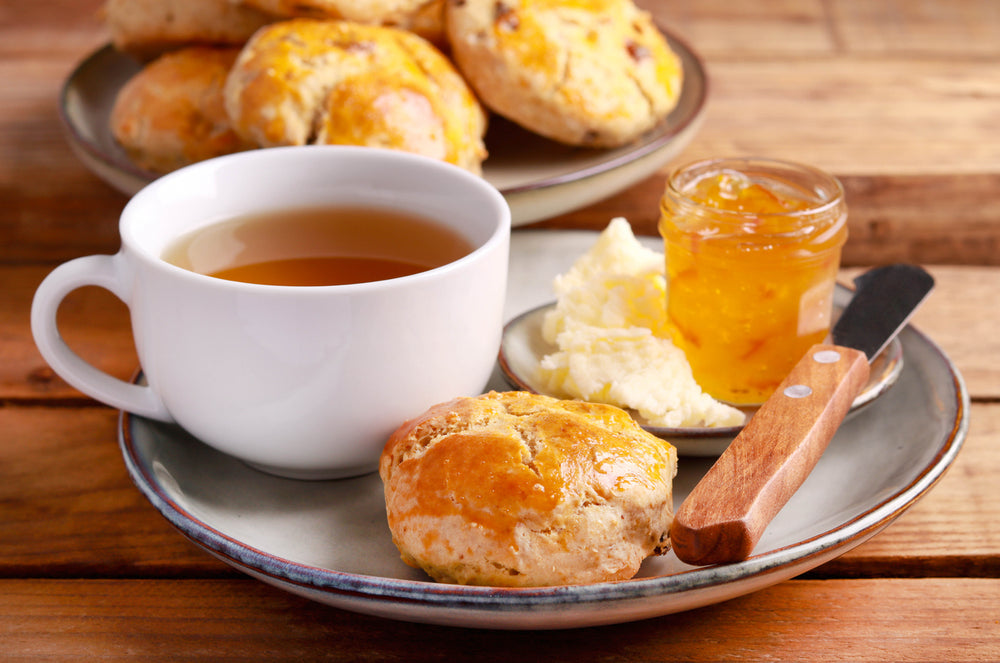The flamboyant and glowing orange marmalade holds a special place in the hearts of the British. Its tangy and citrusy flavour, which comes from Seville oranges from which it has been made, leaves a lingering taste. Marmalade has long been a staple on British breakfast tables. The people have always loved it, and even Captain Scott brought jars of marmalade on his tragic Antarctic expedition to the South Pole.
A History of Orange Delight
The word comes from the Portuguese word marmalade, which describes a quince paste and is derived from the English word quince. During the Tudor era, marmalade, a quince preserve, was exported to Britain. Marmalades, or thick, solid pastes made from lemons and bitter oranges, were first brought into Britain from Spain and Portugal. The invention of orange marmalade in the form that we know it today is attributed to Scotland in the 18th century.
According to legend, James Keiller, a Scottish grocery store owner, purchased a bargain shipment of bitter oranges from a Spanish boat that was seeking refuge in Dundee Harbour. Oranges were chopped, and the peel and sugar were boiled together by his mother, Janet Keiller. She cooked the mixture for a shorter period to produce a spreadable 'marmalade' that could be spread on toast instead of boiling it until it solidified into a paste. The Keiller family constructed Dundee's first marmalade factory in 1797. They began exporting their marmalade to Australia, India, and South Africa, among other nations. When the British Trademark Registry Act was passed in 1876, one of the first brands to be registered was Keiller's Dundee Orange Marmalade.
Ingredients of Marmalade

The main ingredient of marmalade is oranges. Authentic marmalade is made from bitter Seville oranges; however, sweet oranges, lemon, grapefruit, kumquat, and lime are also used to make this delicious spread. Other fruits are also added to create unique flavours.
Lemon, water, and sugar are the other ingredients that go into making this delicious delight.
Here is a Recipe for Traditional Seville Marmalade
Ingredients
- 4 to 5 large Seville oranges
- 1 large lemons
- 8 cups of sugar (granulated)
- 6 cups of water
Method of Preparation:

- Wash the oranges and lemon and cut them in halves. Squeeze out their juice, remove their seeds, and set them aside.
- Slice the squeezed halves into thin slices. If you want a traditional marmalade, then keep the seeds else you can discard them.
- Take a heavy-bottomed pan and add the sliced fruits to it.
- Next, add the water and bring the contents to a boil. Reduce the heat and let it cook for 45 – 60 minutes. Use a fork to check if the peels are tender – you should be able to easily pierce it.
- To this, add the juice and the sugar. Dissolve the sugar by stirring and bring the mixture to a boil once again. Simmer the heat and cook for 45 – 60 minutes. The marmalade should have become thick and glossy.
- Once done, store them in sterilized glass jars while it is hot. Seal the jars when the marmalade is still hot, and as the jars cool down, you will hear a pop sound, which means the jars have sealed tight.
- You must cool the jars till they are at room temperature before storing them in a cool and dark place. If sealed properly, they will last you for months.

Pairings for Marmalade
Orange marmalade is not just meant to be spread on a scone or toast, but it is a flavour and important ingredient that adds sweetness and citrus zing to chicken, cakes, ham, seafood, fruit salads, cookie, and more.
Orange marmalade is a fruity and tangy ingredient that can be used to prepare dishes for breakfast, lunch, dinner, and dessert. Here are a few pairings that you should try with marmalade:
Toast and Scones
Spread marmalade on toast, scones, and crumpets for a delicious breakfast or a midday or evening snack to quieten that grumbling belly.
Grilled Meats

Marmalade can be used as a glaze for roasted meats to give them a zesty and tangy flavour. Ham, pork, and chicken taste wonderful with marmalade.
Cheese
Cheeses like Brie, cheddar, and goat cheese taste heavenly with marmalade. You can use it for cheese and crackers topping or place a small bowl of it as a dip on your cheese platter.
Desserts
If you want to add a fresh and citrusy flavour to your desserts, use marmalade to fill your tarts, pastries, and thumbprint cookies.
Yogurt
Add marmalade to yogurt for a unique tangy and sweet taste – a delicious yogurt parfait for breakfast!
Salads
Vinaigrette dressing will taste amazing if you add marmalade to the vinegar and olive oil mixture. Just a tiny drizzle over your salad will completely transform its taste.
Ice Cream
Add a spoonful of marmalade for a nice fruit punch to your ice cream! You will have created a new delicious flavour for yourself.
Peanut Butter Sandwiches
Replace the classic jam with a layer of marmalade in your sandwich, and then experience the magical burst of flavours as you bite into it.
Cocktails
Marmalade can also be used to flavour cocktails. It really goes well with drinks like marmalade martinis or as a mixer for some cocktails.
Tea
Give your tea a fresh orange taste by stirring in a spoon of marmalade.
Conclusion

Marmalade has seen centuries of British history, and it still stands as one of the most loved British ingredients. It has seen wars and uprisings and survived plagues and fires. People don't wait for an occasion to purchase or make marmalade. Its adaptability and timeless appeal set it apart from other foods.


 Easter 2026
Easter 2026
 Frozen Food
Frozen Food
 Baking
Baking
 Beans, Peas, Soups & Tins
Beans, Peas, Soups & Tins
 Biscuits, Crackers & Cookies
Biscuits, Crackers & Cookies
 Candy / Sweets
Candy / Sweets
 Crisps & Snacks
Crisps & Snacks
 Chemist / Pharmacy
Chemist / Pharmacy
 Desserts
Desserts
 Gravy, Stock & Paste
Gravy, Stock & Paste
 Haggis
Haggis
 Indian Sauces, Paste and Pickle
Indian Sauces, Paste and Pickle
 Jams & Preserves
Jams & Preserves
 Poppy Appeal
Poppy Appeal
 Pot Noodles & Super Noodles
Pot Noodles & Super Noodles
 Scone Mix
Scone Mix
 Gluten-Free / Free From
Gluten-Free / Free From
 Tea Accessories
Tea Accessories
 Teapot & Tea sets
Teapot & Tea sets
 Tea For One
Tea For One
 Sugar & Creamer
Sugar & Creamer
 Tableware
Tableware
 Serveware
Serveware
 Plates & Trays
Plates & Trays
 Bowls
Bowls
 Cups & Saucers
Cups & Saucers
 Mugs
Mugs
 Silverware
Silverware
 Dinnerware - Accessories
Dinnerware - Accessories
 Dinnerware - For Pets
Dinnerware - For Pets
 Victoria Eggs - Hand-Drawn UK Homeware
Victoria Eggs - Hand-Drawn UK Homeware
 Jewelry & Accessories
Jewelry & Accessories
 Sale
Sale
 Christmas Gifts
Christmas Gifts

